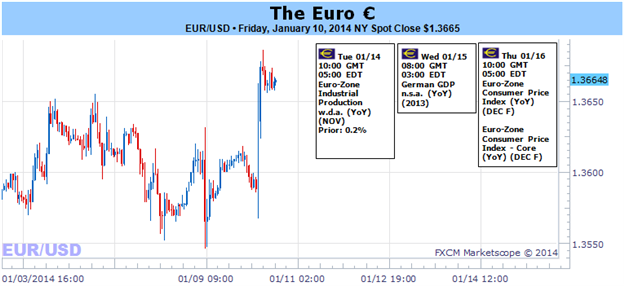
Fundamental Forecast for Euro: Neutral
The ECB chose to ‘jawbone’ rather than change policy, but Draghi’s emphasis was on rate cuts rather than QE
Record low, short-term Spanish and Italian yields reflect investor exuberance rather than a genuine risk profile
Do you think the Euro will rise or fall over the medium-term? Use the Euro Currency Basket to trade a longer-term view
The euro ended this past week little changed as key event risk failed to stir deeper fundamental waters. In particular, the hold by the European Central Bank (ECB) with little clarity for the recent speculation for a possible future stimulus upgrade has curbed pressure for an FX market that is paying closer attention to relative monetary policy. Meanwhile, European capital markets have been the benefactor of extraordinary capital inflows whose pace far outstrips the forecast for the economic backdrop – leaving the region and the currency exceptionally exposed to any changes in global sentiment moving forward.
While the Euro will face more than its fair share of troubles as we head into the second full week of 2014, an immediate threat has been significantly reduced. Relative monetary policy has become one of the most prominent drivers for the FX market as central banks like the Bank of Japan (BoJ) drive forward with plans to significantly expand its stimulus program while the Federal Reserve has taken the first steps to curb its accommodation with the Taper. Though officials may not freely admit that at least part of the aim with such efforts is to devalue their respective currencies, the effects are felt nonetheless. The size of a central bank balance sheet – and more importantly the expectations for its growth – can materially devalue a currency whether through money supply factors or interest rate influences.
For the European authority, the economic picture is more compelling for a move to ease rather than tighten. Many Eurozone members are still mired in recession, the region’s unemployment rate is still at record highs and inflation has dropped to a multi-decade low. These are the same conditions that encouraged the ECB to cut rates in November. Yet, at 0.25 percent, there is little room to continue with these standard measures. Negative deposit rates or a targeted stimulus program are the more effective moves now. However, these extraordinary steps are not taken lightly. The Outright Monetary Transactions (OMT) program that would buy bonds should a sovereign crunch develop was instituted with yields at extreme levels. For the financial sector, the Long-Term Refinancing Operations (LTRO) that provided cheap loans to banks were also implemented in the throes of a crisis. Today, the measure of risk for both fronts is extremely low.
So, with the ECB merely threatening to do ‘whatever is needed’, the risk of a BoJ-like stimulus move that could significantly devalue the currency is seen as lower probability. In contrast, the December US NFPs have tripped up speculation of progress towards austerity (and interest rates) for the US dollar. In the global financial market, that relative benefit is felt by the euro.
However, those same measures of extraordinarily low concern in Europe’s financial market should concern investors and traders. Spanish and Italian two-year sovereign yields hit record lows this past week. That is an unusually low level of concern from the market considering the former has a record unemployment rate of 26.7 percent and the latter holds Europe’s largest debt. Furthermore, the equity market benchmarks for the region’s more fundamentally-troubled members posted the best performance this past week.
These markets are reflecting investor exuberance rather than genuine confidence. After the implementation of the ECB’s major stimulus programs as fear of Eurozone instability cooled, astute speculators – emboldened by a sense of confidence fortified by the moral hazard of global stimulus – poured money into the region’s markets to access the inflated yields that the crisis had leveraged. Between 6 and 7 percent (on 10-year government bonds), these may have been good risk-reward considerations. Yet, now at multi-year and record lows, the low-hanging fruit is all but spent. The torrent of investor inflow risks turning into a trickle and possibly reversing.
Like other global market extremes – such as the S&P 500 at record highs, the exposure in high-yield assets and appetite for yen crosses – the euro is at the mercy of sentiment. Recently volatility (used as a measure of ‘fear’) dropped to extreme lows. Yet, the economic, financial and fundamental backdrops do not look so abundant. Should concern rise and deleveraging begin, the capital reversal out of Europe could prove volatile – presenting a looming but incredible risk for the currency. – JK
DailyFX provides forex news and technical analysis on the trends that influence the global currency markets.Learn forex trading with a free practice account and trading charts from FXCM.
Source: Daily fx
